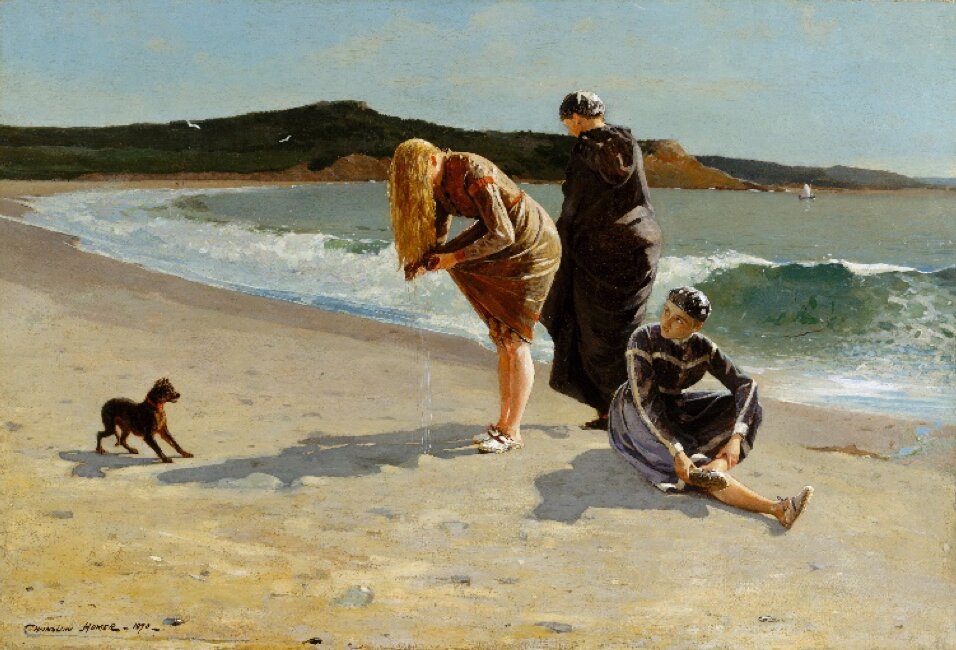
This article has been updated.
When the artist Winslow Homer came to paint on Cape Ann in 1869, he arrived as a busy commercial illustrator for popular magazines of the day.
Over the next eleven years, spending significant time in coastal areas across the northeast, including Gloucester and Manchester, Homer left a master of fine art whose paintings captured evocative moments of coastal life.
This was a theme in a thought-provoking lecture by Elizabeth L. Block, PhD, senior editor at the Metropolitan Museum of Art in New York, “Winslow Homer and Women’s Bathing Practices,” which was jointly presented in 2019 by the Cape Ann Museum and Historic New England.
The beach as subject matter was a hot topic in Homer’s time, according to Block. With the post-Civil War letdown and further development of railroad travel, the concept of leisure came to Americans at every level, and with it, so did the whole “by the sea” lifestyle.
Homer, a native of the Boston area, was a working commercial illustrator contracted by magazines like Appletons’ Journal and Harper’s Weekly. Homer often featured shore life in his commercial work, presenting it — as any magazine might — as an aspirational affair. His work commonly featured women and men enjoying the water and wading out together and (within reason, one imagines) the mingling of different social classes.
This reflected the trends of the time in America. Central Park had been created in New York City. Large "grand" hotel lobbies began to emerge, emphasizing social mixing, lingering, and entertainment.
And there was the beginning of public beaches. In Massachusetts, Revere Beach, just north of Boston, is credited as America's first public beach in 1895. Long before this, a trend developed of seeking health benefits from the sea, which, according to Block, sparked a population boom in coastal communities like Martha’s Vineyard, Bar Harbor, ME, Long Branch, NJ, and here in Cape Ann. In fact, Block said Manchester-by-the-Sea’s coastal waters were thought to be curative for hay fever and asthma.
According to Block, fashion was central to Homer's commercial engravings and woodcuts — with much of it offering a “see and be seen” theme. Beauty, fashion, and social preening permeate Homer’s magazine beach illustrations. Women in elaborate dresses and bonnets, their silk ribbons blowing in the coastal winds and balanced by proper gloves and parasols.
In reality, Block said women’s 19th-century “bathing suits” were far from fun. Full-length and made of wool, Block said, women’s swimming attire required long pants to cover legs and often with long sleeves as well. Oiled silk caps covered their hair, and until the 1890s, women had the added constraints of boned corsets under bathing suits for modesty. Yes, said Block, leisure "bathing" was a dangerous business for women of the time. Drownings were common byproducts of this new activity.
But fashion in commercial art is the job, and fashion in fine art is not. Block said that Homer easily separated the two, navigating his practical reality of making a living with his aspirations to be a fine artist. This is no more apparent than in his painting, “Eagle Head,” depicting three women on the shores of Singing Beach in Manchester. With "Eagle Head," Block said, we see Homer as a fine artist powerfully showing an America in transition, with its changing realities of class and gender, and presenting the noble, simple beauty of the coast and the people living their lives near it.
Today's contemporary eye sees Homer’s “Eagle Head” as a quiet view of three women in a strikingly intimate moment, gathering themselves post-swim. One flips her dripping wet, long hair upside down to dry it while her friend sits beside her, tying her shoes. A third woman stands with them, her back to the painter. None are posing or seem aware of being watched. A small terrier dog is off to their side, at the ready for something. Perhaps to be engaged or fed. Or possibly defending his turf.
Yet, "Eagle Head" was universally panned by critics when it debuted in New York’s National Academy of Design’s spring 1870 show, Block said. Its subject matter was offensive to New York society's eyes, which preferred ordered, idealized seascapes and landscapes. The bare legs and tanned skin (“brick-dust color,” one critic derisively said) revealed these women to be working-class—unacceptable subjects for fine art at that time. Further, critics said Homer's landscape was presented crudely, and Singing Beach felt empty, perhaps lonely and depressing to National Academy of Design patrons.
But Homer, still at his life's practical intersection between commercial and fine art, had revamped "Eagle Head" in an alternative, adapted illustration called “High Tide,” published in the August 1870 edition of Every Saturday magazine.
Created at the publisher’s discretion, "High Tide" was appropriate and commercial, with little nips and tucks that cleansed it of the original painting’s offenses. The brick-dust-colored legs of the women’s exposed legs were covered. The seated woman now offered a pleasant, soft smile that replaced her facial expression of directness in "Eagle Head." A smattering of people enjoying Singing Beach was added to the background. The rocks of Eagle Head in the background were lowered, and a steamship was inserted into the ocean horizon. And — for some reason — the dog was replaced with a bathing cap. With these adjustments—voila!—"High Tide" was ready for public consumption.
We know Homer moved on from commercial illustration and became one of the most influential painters in America, known for his naturalistic watercolor and oil seascape paintings.
"Eagle Head" is now considered a triumph and hangs in the Metropolitan Museum of Art in New York as part of its permanent collection.